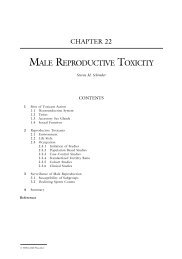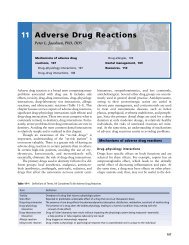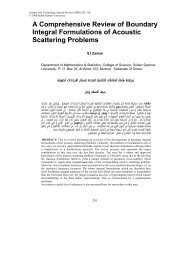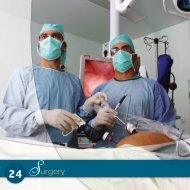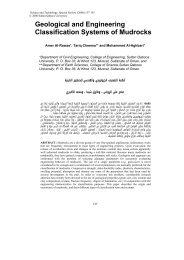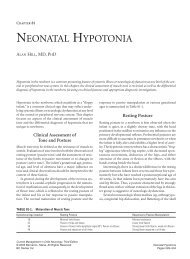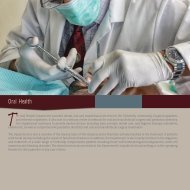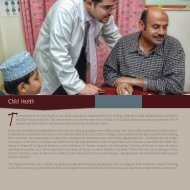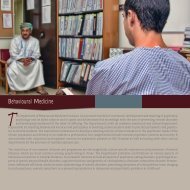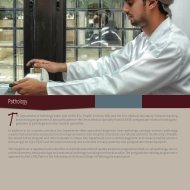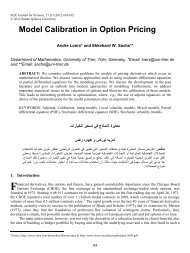Ch05: Red and White Lesions of the Oral Mucosa
Ch05: Red and White Lesions of the Oral Mucosa
Ch05: Red and White Lesions of the Oral Mucosa
You also want an ePaper? Increase the reach of your titles
YUMPU automatically turns print PDFs into web optimized ePapers that Google loves.
<strong>Red</strong> <strong>and</strong> <strong>White</strong> <strong>Lesions</strong> <strong>of</strong> <strong>the</strong> <strong>Oral</strong> <strong>Mucosa</strong> 107<br />
following <strong>the</strong> elimination <strong>of</strong> suspected irritants is acceptable,<br />
but prompt biopsy at that time is m<strong>and</strong>atory for lesions that<br />
persist. The toluidine blue vital staining procedure may be<br />
redone following <strong>the</strong> period <strong>of</strong> elimination <strong>of</strong> suspected irritants.<br />
<strong>Lesions</strong> that stain on this second application frequently<br />
show extensive dysplasia or early carcinoma. Epi<strong>the</strong>lial dysplasia<br />
or carcinoma in situ warrants complete removal <strong>of</strong> <strong>the</strong><br />
lesion. Actual invasive carcinoma must be treated promptly<br />
according to guidelines for <strong>the</strong> treatment <strong>of</strong> cancer. Most<br />
asymptomatic malignant erythroplakic lesions are small; 84%<br />
are ≤ 2 cm in diameter, <strong>and</strong> 42% are ≤ 1 cm. 165–167 However,<br />
since recurrence <strong>and</strong> multifocal involvement is common, longterm<br />
follow-up is m<strong>and</strong>atory.<br />
▼ ORAL LICHEN PLANUS<br />
<strong>Oral</strong> lichen planus (OLP) is a common chronic immunologic<br />
inflammatory mucocutaneous disorder that varies in appearance<br />
from keratotic (reticular or plaquelike) to ery<strong>the</strong>matous<br />
<strong>and</strong> ulcerative. About 28% <strong>of</strong> patients who have OLP also have<br />
skin lesions. 173–175 The skin lesions are flat violaceous papules<br />
with a fine scaling on <strong>the</strong> surface. Unlike oral lesions, skin<br />
lesions are usually self-limiting, lasting only 1 year or less. The<br />
lack <strong>of</strong> sound epidemiologic studies <strong>and</strong> <strong>the</strong> variations in signs<br />
as well as symptoms make estimates <strong>of</strong> prevalence difficult.<br />
Etiology <strong>and</strong> Diagnosis<br />
The etiology <strong>of</strong> lichen planus involves a cell-mediated immunologically<br />
induced degeneration <strong>of</strong> <strong>the</strong> basal cell layer <strong>of</strong> <strong>the</strong><br />
epi<strong>the</strong>lium. Lichen planus is one variety <strong>of</strong> a broader range <strong>of</strong><br />
disorders <strong>of</strong> which an immunologically induced lichenoid<br />
lesion is <strong>the</strong> common denominator. 176–178 Thus, <strong>the</strong>re are many<br />
clinical <strong>and</strong> histologic similarities between lichen planus <strong>and</strong><br />
lichenoid dermatoses <strong>and</strong> stomatitides associated with drugs,<br />
some autoimmune disorders, <strong>and</strong> graft-versus-host reactions.<br />
179,180 Although lichen planus may manifest as a particularly<br />
well-defined <strong>and</strong> characteristic lesion, <strong>the</strong> differential diagnosis<br />
for less specific lesions is extensive. Speculated c<strong>of</strong>actors<br />
in causation, such as stress, diabetes, hepatitis C, trauma, <strong>and</strong><br />
hypersensitivity to drugs <strong>and</strong> metals, have varying degrees <strong>of</strong><br />
support, with <strong>the</strong> last three having <strong>the</strong> most convincing evidence.<br />
174,175,181,182 At <strong>the</strong> very least, some <strong>of</strong> <strong>the</strong>se factors may<br />
add to <strong>the</strong> risk <strong>of</strong> developing OLP in susceptible patients.<br />
As stated above, in “true” OLP a specific causative factor<br />
cannot be identified. However, clinical <strong>and</strong> microscopic changes<br />
that are consistent with OLP will <strong>of</strong>ten occur in response to a<br />
variety <strong>of</strong> agents (eg, drugs, chemicals, metals, <strong>and</strong><br />
foods). 174,183,184 When <strong>the</strong>se manifestations take place, <strong>the</strong>y are<br />
referred to as “lichenoid” reactions. When <strong>the</strong> <strong>of</strong>fending agent<br />
or antigen is removed, <strong>the</strong> signs <strong>and</strong> symptoms are reversed;<br />
examples in reported cases include reactions to dental restorations,<br />
mouth rinses, antibiotics, gold injections for arthritis, <strong>and</strong><br />
immunocompromised status such as graft-versus-host disease.<br />
174,176,183 These reactions are not to be confused with o<strong>the</strong>r<br />
hypersensitivity reactions such as urticaria or ery<strong>the</strong>ma multiforme,<br />
which differ both clinically <strong>and</strong> microscopically.<br />
These <strong>of</strong>ten confusing clinical variations (Figure 5-34)<br />
m<strong>and</strong>ate a thorough clinical work-up <strong>and</strong> histologic examination<br />
to rule out possible dysplasia <strong>and</strong> carcinoma. This<br />
requires not only an initial biopsy but also follow-up biopsies<br />
when changes in signs <strong>and</strong> symptoms occur.<br />
(Because some lesions <strong>of</strong> oral lichen planus are erosive <strong>and</strong><br />
o<strong>the</strong>rs are bullous, this disorder is also discussed in Chapter 4.<br />
The emphasis in this chapter is on <strong>the</strong> white non-erosive nonbullous<br />
forms <strong>of</strong> lichen planus.)<br />
Clinical Features<br />
In general, studies <strong>of</strong> patients with OLP reveal that <strong>the</strong>re is no<br />
evident genetic bias or uniform etiologic factor. The mean age<br />
<strong>of</strong> onset is <strong>the</strong> fifth decade <strong>of</strong> life, <strong>and</strong> <strong>the</strong>re is clearly a female<br />
predominance. Although OLP may occur at any oral mucosal<br />
site, <strong>the</strong> buccal mucosa is <strong>the</strong> most common site. OLP may be<br />
associated with pain or discomfort, which interferes with function<br />
<strong>and</strong> with quality <strong>of</strong> life. Approximately 1% <strong>of</strong> <strong>the</strong> population<br />
may have cutaneous lichen planus. The prevalence rate<br />
<strong>of</strong> OLP ranges between 0.1 <strong>and</strong> 2.2%. 27,30,173,174 The skin<br />
lesions <strong>of</strong> lichen planus have been classically described as purple,<br />
pruritic, <strong>and</strong> polygonal papules.<br />
OLP is classified as reticular (lacelike keratotic mucosal<br />
configurations), atrophic (keratotic changes combined with<br />
mucosal ery<strong>the</strong>ma), or erosive (pseudomembrane-covered<br />
ulcerations combined with keratosis <strong>and</strong> ery<strong>the</strong>ma) <strong>and</strong> bullous<br />
(vesiculobullous presentation combined with reticular or<br />
erosive patterns). 181,185 Apart from <strong>the</strong> erosive <strong>and</strong> bullous<br />
forms <strong>of</strong> <strong>the</strong> disorder, reticular OLP is quite frequently an<br />
indolent <strong>and</strong> painless lesion that is usually asymptomatic<br />
before it is identified during a routine oral examination. The<br />
clinical features <strong>of</strong> <strong>the</strong> lesions in a given patient <strong>of</strong>ten vary<br />
with time, as does <strong>the</strong>ir extent <strong>and</strong> <strong>the</strong> area <strong>of</strong> erosion <strong>of</strong> <strong>the</strong><br />
atrophic mucosa. 181<br />
The reticular form consists <strong>of</strong> (a) slightly elevated fine<br />
whitish lines (Wickham’s striae) that produce ei<strong>the</strong>r a lacelike<br />
pattern or a patern <strong>of</strong> fine radiating lines or (b) annular<br />
lesions. This is <strong>the</strong> most common <strong>and</strong> most readily recognized<br />
form <strong>of</strong> lichen planus. Most patients with lichen planus at<br />
some time exhibit some reticular areas. The most common<br />
sites include <strong>the</strong> buccal mucosa (<strong>of</strong>ten bilaterally), followed by<br />
<strong>the</strong> tongue; lips, gingivae, <strong>the</strong> floor <strong>of</strong> <strong>the</strong> mouth, <strong>and</strong> <strong>the</strong><br />
palate are less frequently involved. Whitish elevated lesions, or<br />
papules, usually measuring 0.5 to 1.0 mm in diameter, may be<br />
seen on <strong>the</strong> well-keratinized areas <strong>of</strong> <strong>the</strong> oral mucosa.<br />
However, even large plaquelike lesions may occur on <strong>the</strong><br />
cheek, tongue, <strong>and</strong> gingivae, <strong>and</strong> <strong>the</strong>se are difficult to distinguish<br />
from leukoplakia.<br />
Bullous lichen planus (see Chapter 4) is rare <strong>and</strong> may<br />
sometimes resemble a form <strong>of</strong> linear IgA disease. 186 Atrophic<br />
lichen planus presents as inflamed areas <strong>of</strong> <strong>the</strong> oral mucosa<br />
covered by thinned red-appearing epi<strong>the</strong>lium. Erosive lesions<br />
probably develop as a complication <strong>of</strong> <strong>the</strong> atrophic process<br />
when <strong>the</strong> thin epi<strong>the</strong>lium is abraded or ulcerated. These lesions<br />
are invariably symptomatic, with symptoms that range from<br />
mild burning to severe pain.





